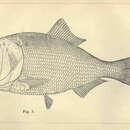Brevoortia is a genus containing six species of small, oily, 6-12 inch long marine fish related to the herrings (family Clupeidae). All six species are found in the western Atlantic, in tight, slow-moving, near-surface shoals; the various species inhabit estuaries, coastal waters and off-shore waters out to the edge of the continental shelf. They spawn at any time of year, especially in coastal estuaries. Known commonly as menhaden, pogy, fatback, and mossbunker,
Brevoortia, especially the gulf menhaden (
B. petronus) and Atlantic menhaden (
B. tyrannus) are important economically and the major contributors to commercially available fish oil (especially omega-3 fatty acids), fish meal and bait. In addition, menhaden are ecologically vital as filter feeders on algae and phytoplankton and as important mechanisms for migrating excess nutrients that cause algal blooms out of coastal waters, and as a prey source supporting the existence of a wide diversity of fish bird and marine mammal species. The important ecological role of the Atlantic menhaden (
B. tyrannus) and decline of this species is discussed in a recent book “The Most Important Fish in the Sea,” by H. B. Franklin, published in 2007. The Atlantic States Marine Fisheries Commission, an interstate agreement that manages Atlantic menhaden, considers populations healthy overall, but overfished and locally depleted and in 2006 capped fishing in the Chesapeake Bay. (
Franklin 2001; Franklin 2007;
Wikipedia 2012;
Wikipedia 2012;
Waine 2011)

